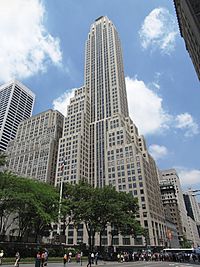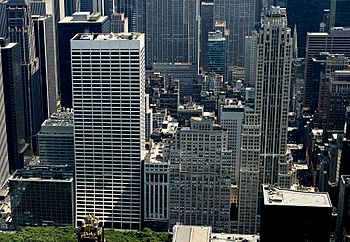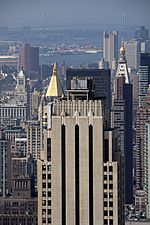500 Fifth Avenue facts for kids
Quick facts for kids 500 Fifth Avenue |
|
|---|---|
 |
|
| General information | |
| Type | Office |
| Architectural style | Art Deco |
| Location | New York City, United States |
| Coordinates | 40°45′14″N 73°58′53″W / 40.753836°N 73.981279°W |
| Construction started | 1929 |
| Completed | 1931 |
| Opening | March 3, 1931 |
| Owner | 1472 Broadway, Inc. |
| Height | |
| Roof | 697 feet (212 m) |
| Technical details | |
| Floor count | 60 |
| Floor area | 659,132 sq ft (61,235.4 m2) |
| Design and construction | |
| Architect | Shreve Lamb & Harmon Associates |
| Developer | Walter J. Salmon Sr. |
| Structural engineer | McClintic-Marshall Co. |
| Main contractor | Charles T. Wills Inc. |
| Designated: | December 14, 2010 |
| Reference #: | 2427 |
500 Fifth Avenue is a 60-floor, 697-foot-tall (212 m) office building on the northwest corner of Fifth Avenue and 42nd Street in Midtown Manhattan, New York City. The building was designed by Shreve, Lamb & Harmon in the Art Deco style and constructed from 1929 to 1931.
500 Fifth Avenue was designed with a facade of bronze, limestone, and terracotta at the base, and a facade of brick above the fourth floor. While the lowest four floors contain a decorative exterior, little ornamentation is used above the base. The primary entrance is on Fifth Avenue, and storefronts are located at ground level. Upon its opening, the building contained design features including fast elevators, well-lit office units, and a floor plan that maximized the well-lit office space. The 1916 Zoning Resolution resulted in a structure that incorporated setbacks, resulting in the lower floors being larger than the upper floors.
500 Fifth Avenue was built for businessman Walter J. Salmon Sr. In the 1920s, prior to the building's development, the underlying land had become extremely valuable. Similar to the Empire State Building nine blocks south, which was being constructed simultaneously, 500 Fifth Avenue's construction was highly coordinated. 500 Fifth Avenue opened in March 1931, but it was overlooked by the much larger Empire State Building. The building was designated an official city landmark by the New York City Landmarks Preservation Commission in 2010.
Contents
Site
500 Fifth Avenue occupies the northwestern corner of Fifth Avenue and 42nd Street in the Midtown Manhattan neighborhood of New York City. It is adjacent to the Manufacturers Trust Company Building to the north and the Salmon Tower Building to the west, while Bryant Park and the New York Public Library Main Branch are located nearby to the south.
Mansions and other residences were constructed on Fifth Avenue in the late 19th century, and office and commercial buildings were being developed on the avenue by the beginning of the 20th century. By 1923, the Rider's Guide to New York City referred to the blocks of East 42nd Street between Park and Fifth Avenues as "Little Wall Street". The Real Estate Record & Guide called the area "the most valuable building site on Manhattan Island north of Wall Street".
Design

Shreve, Lamb & Harmon designed the building. William F. Lamb, a lead associate at the firm, called 500 Fifth Avenue "a thoroughly frank expression of the requirements of an up-to-date office building."
Form
The 1916 Zoning Resolution resulted in a structure that incorporated setbacks, resulting in the lower floors being larger than the upper floors. Due to the different zoning requirements on Fifth Avenue and on 42nd Street, different designs were used for each side. 500 Fifth includes numerous setbacks on each side, which are complex and asymmetrical. The first setback on 42nd Street is located at a higher story than the first setback on Fifth Avenue. Namely, the Fifth Avenue side's setbacks are located at the 18th, 22nd, and 25th stories, while the 42nd Street side's setbacks are at the 23rd, 28th, and 34th stories. At the time, the heights of skyscrapers in New York City were limited by the perceived economic feasibility of the upper floors. For the lot that 500 Fifth Avenue occupied, which measured 100 by 208 feet (30 by 63 m), this maximum height was considered to be 59 stories including a penthouse, or roughly 697 feet (212 m).
Facade
The building's primary entrance is on Fifth Avenue about 70 feet (21 m) north of 42nd Street. Storefronts are located at ground level on the eastern and southern elevations. As a result of the creation of a special Fifth Avenue zoning district in 1929, new buildings on Fifth Avenue within Midtown had to include stores on their first two floors. At the main entrance was an allegorical relief depicting the building's construction, which was made of limestone and carved by Edward Amateis. Ornamentation depicting a pair of carved eagles is located on the 42nd Street facade.
Lamb cited several factors in the "modern architectural treatment" of 500 Fifth, including the ornamentation and material usage. Bronze, limestone, and terracotta were used on the base's facade, while above the fourth floor, the exterior was made mainly of brick. The second through fourth floors contained decorated limestone piers as well as light-green spandrels ornamented with chevrons and folds. The tower above the fourth floor consisted of recessed brick spandrels with black terracotta panels, which provided "vertical accents" to the building. The idea for the terracotta-and-brick spandrels of the tower was probably taken from the Daily News Building, where a similar spandrel design was used. Little ornamentation is used above the base, except for terracotta panels with chevrons along the facade of the tower.
Features
500 Fifth's design features included fast elevators, well-lit office units, and a floor plan that maximized the well-lit office space. Like the exactly contemporary Empire State Building, 500 Fifth was designed from the top down; the floor plans within the upper stories were planned first, followed by the floor plans of the lower stories and the building's base. Offices above the sixth floor were designed so that each unit was a maximum of 30 feet (9.1 m) away from a window or other source of natural light. The area of each floor could be between 2,150 to 18,000 square feet (200 to 1,672 m2). Office sizes ranged from the smallest units being 9 feet (2.7 m) wide to the largest units covering the entire floor; on average, there were 21 units on each floor within the base, and 9 units on each floor within the tower section.
History
Land acquisition
From the 1890s to the 1910s, entrepreneur Walter J. Salmon purchased or leased several buildings along the northern side of West 42nd Street. His first acquisitions were 19 and 21 West 42nd in 1899 and 1901, respectively. In 1903, he signed a 20-year lease for the lot at the northwest corner of Fifth Avenue and 42nd Street, which was occupied by the Hotel Bristol, an eight-story structure built in 1875. The terms of the lease enabled Salmon to convert the hotel to commercial and office use. In 1905, he leased the brownstone rowhouses at 11-17 West 42nd Street and the six-story building at 27-29 West 42nd Street, and the following year, he acquired the properties at 23-25 West 42nd. When Salmon leased the remaining buildings between 3-9 West 42nd Street in 1915, he controlled 858 feet (262 m) along the northern side of the street between Fifth Avenue and 29 West 42nd. His parcels totaled 50,900 square feet (4,730 m2), which was considered to be the "minimum size necessary for profitable redevelopment".
Salmon's company, the Midpoint Realty Company, made an agreement with the site's owners, Gerry Estates Inc., for the corner lot's redevelopment in January 1922. Salmon signed a long-term lease for both the Bristol Building and the buildings at 3-9 West 42nd Street. In 1927, Salmon acquired a four-story residence at 508 Fifth Avenue for his corner lot development. The adjacent lots at 11-27 West 42nd would become the Salmon Tower Building, which was completed in 1928. However, the development of the corner site was delayed because of a legal dispute between Salmon and wool merchant Morton Meinhard, who was to provide half of the money for the site's development but did not have any say in the 1922 lease. The New York Supreme Court's Appellate Division ruled in June 1929 that Meinhard was entitled to a half-stake in the site.
Planning and construction
In July 1929, Salmon announced his plans for the corner lot, a 58-story building at 500 Fifth Avenue, measuring 100 feet (30 m) along Fifth Avenue and 208 feet (63 m) along 42nd Street. The skyscraper was estimated to cost $2.35 million and be completed in late 1930. The Real Estate Record wrote that "the time appeared ripe for an improvement on this corner". The lot was considered the second-most-valuable undeveloped lot in Manhattan, behind 1 Wall Street.
Shreve, Lamb & Harmon were selected to design the new building. Because the zoning ordinances allowed higher buildings along 42nd Street than Fifth Avenue, Salmon merged the zoning lots of 500 and 508 Fifth Avenue, enabling him to construct a taller building than was usually permitted. This also required a separate design for the Fifth Avenue side of the building. Some 450,000 to 500,000 square feet (42,000 to 46,000 m2) of rentable office space would be provided, as well as space for banking on the second and third floors, and retail on the first floor. The plans called for numerous architectural features including setbacks and "light courts". The New York City Department of Buildings received plans for 500 Fifth Avenue in October 1929. The following month, the Bristol Building's tenants were evicted, and that December the Bristol Building was demolished. The demolition was complete in January 1930 and excavation of the foundation began the next month.
Similar to the Empire State Building nine blocks south, which was being constructed simultaneously, each structural component at 500 Fifth Avenue was planned in advance. According to architect Richmond Shreve—a lead associate at Shreve, Lamb & Harmon, which designed both buildings—the former's construction "required feats of organization in some respects never before attempted." 500 Fifth Avenue was erected by general contractor Charles T. Wills Inc. and steel contractor McClintic-Marshall Co. The steel contractor started assembling the steel frame in March 1930, and using a system of derricks to expedite construction, was able to complete the steel structure by that July. The brickwork for the building was completed by that September. By December 1930, the building was essentially complete, and 500 Fifth Avenue officially opened in March 1931. The construction process employed up to 2,200 workers, and ultimately cost $4 million. John Tauranac, in his book The Empire State Building: The Making of a Landmark, wrote that upon 500 Fifth's completion, "The Building Record and Guide was calling Forty-second Street and Fifth Avenue 'the best known corner in the world'."
Use
In its early years, 500 Fifth Avenue was largely overlooked, as more attention was placed upon the Empire State Building, the world's tallest building at the time. Furthermore, office rental activity was affected by the Wall Street Crash of 1929. Salmon said in December 1930 that although he foresaw it might take a long time to fill the space at 500 Fifth Avenue, "the enterprise was undertaken with the greatest faith in the future of midtown expansion and development." The 15th, 16th, and 20th floors were completely rented by May 1931. Rental activity continued, and by the end of the year, lessees included Electrolux, Western Universities Club, and over ten railroad companies. Other tenants included the Austrian and Japanese consulates, which had moved into the building by the mid-1930s. 500 Fifth Avenue was the original transmitter site for CBS Radio's New York City FM station (W67NY, later called WCBS-FM) in 1941.
The Mutual Insurance Company leased the adjacent lots at 508-514 Fifth Avenue from the Manufacturers Hanover Corporation (then known as the Manufacturers Trust Company) in 1944. Because Salmon's existing lease of 508 Fifth Avenue ran through 1965, Manufacturers Trust subleased the lot at 508 Fifth Avenue from Salmon. The terms of the sublease specified that the portion of any structure at 508 Fifth Avenue could not be more than 63 feet (19 m) tall, or obstruct the adjacent skyscraper in any other way. The Manufacturers Trust Company Building at 508-514 Fifth Avenue was completed in 1954, and ultimately contained four stories and a penthouse. The Manufacturers Trust penthouse was set back from the lot line at 508 Fifth Avenue because it rose above the maximum height permitted in the sublease agreement.
The land under 500 Fifth Avenue was owned separately from the building itself, and in 1955, the land was sold to Metropolitan Life Insurance, now known as MetLife. In 1980, a Yugoslavian bank on the 30th floor was bombed, with Croatian nationalists claiming responsibility, though no one was hurt and the structure suffered minimal damage. The facade was restored in the 1990s and 500 Fifth Avenue continues to be used as an office building.
See also
 In Spanish: 500 Fifth Avenue para niños
In Spanish: 500 Fifth Avenue para niños


